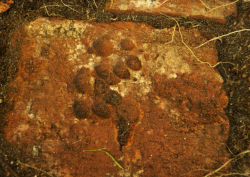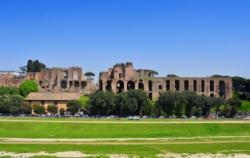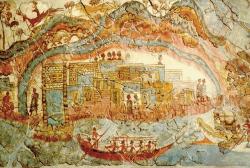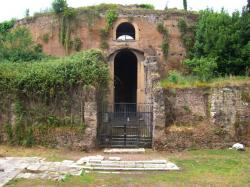INSTITUT SUPERIEUR D'ANTHROPOLOGIE
INSTITUTE OF ANTHROPOLOGY
ONLINE COURSES / COURS A DISTANCE
FALL TERM : OCTOBER 2014
REGISTER NOW
DANEMARK – 

 Hammershus - Dog paw prints on the medieval castle room floor and a cannon ball are the most interesting discoveries of Polish team of archaeologists inside a thirteenth-century castle Hammershus on the island of Bornholm. The third season of excavations carried out by researchers from the Institute of Archaeology, University of Warsaw ended in late July. Hammershus Castle is one of the Bornholm’s most recognizable historic buildings and one of the largest of its kind in Scandinavia. It is the third most important monument of this category in Denmark. This season, the archaeologists have focused on work related to the reconstruction of the castle walls. They have also carried out surveys, limited range excavations, along the southern outer walls and in rooms located in the central part of the castle. On one of the floors they discovered dog paw prints. Close to one of the main entrances to the castle from the harbour side, on the outer side of the wall, archaeologists found almost entirely preserved medieval glass bottle. Scientists still can not clearly answer, who and when built the fortress Hammershus. They hope that the present work will help clarify that. According to the most popular version, castle Hammershus was built by the Archbishop of Lund - Jacob Erlandsen, in the middle of the 12th century. However, the fortifications erected by the archbishop were smaller than those visible today. Many years of renovations and reconstructions have contributed to this situation. Janusz Janowski explained that it was certain that the construction of the defensive structure was closely associated with the struggle for supremacy on the island between the secular (the Lilleborg castle) and religious authorities (Hammershus). Since 1743, the structure began to fall into disrepair. Luckily, already in 1822 the castle was entered in the Danish register of monuments.
Hammershus - Dog paw prints on the medieval castle room floor and a cannon ball are the most interesting discoveries of Polish team of archaeologists inside a thirteenth-century castle Hammershus on the island of Bornholm. The third season of excavations carried out by researchers from the Institute of Archaeology, University of Warsaw ended in late July. Hammershus Castle is one of the Bornholm’s most recognizable historic buildings and one of the largest of its kind in Scandinavia. It is the third most important monument of this category in Denmark. This season, the archaeologists have focused on work related to the reconstruction of the castle walls. They have also carried out surveys, limited range excavations, along the southern outer walls and in rooms located in the central part of the castle. On one of the floors they discovered dog paw prints. Close to one of the main entrances to the castle from the harbour side, on the outer side of the wall, archaeologists found almost entirely preserved medieval glass bottle. Scientists still can not clearly answer, who and when built the fortress Hammershus. They hope that the present work will help clarify that. According to the most popular version, castle Hammershus was built by the Archbishop of Lund - Jacob Erlandsen, in the middle of the 12th century. However, the fortifications erected by the archbishop were smaller than those visible today. Many years of renovations and reconstructions have contributed to this situation. Janusz Janowski explained that it was certain that the construction of the defensive structure was closely associated with the struggle for supremacy on the island between the secular (the Lilleborg castle) and religious authorities (Hammershus). Since 1743, the structure began to fall into disrepair. Luckily, already in 1822 the castle was entered in the Danish register of monuments.
http://www.naukawpolsce.pap.pl/en/news/news,401504,curiosities-of-bornholm-castle.html
ITALIE –  Rome - While Rome just marked the 2,000th anniversary of Emperor Augustus’ death, celebrated yesterday, it’s bad news for an important archeological site built by Rome's first emperor. The stables that housed the horses used for Circus Maximus’ races were discovered in recent years during an excavation project to build a large parking lot on the city’s central via Giulia. Built during Augustus’ reign, they were hailed by archeologists as an extremely important discovery when uncovered in 2009, revealing precious information on how imperial stables were built and on the racing teams of the time through the graffitis found on the walls. In 2011, it was announced the stables would be preserved and open to visits. Those plans unfortunately fell off due to a lack of funding following this year’s budget cuts. The stables will be reburied and covered in waterproof cloths. This is standard procedure, according to officials, to safeguard the site for future generations. This way, artefacts and remains do not risk erosion or thefts, and can be re-excavated when funding permits. Unlike other Roma sites, like the Colosseum, Spanish Steps and Trevi Fountain, whose restoration is being privately funded by fashion houses Tod's, Bulgari and Fendi, no private sponsor so far has come to the rescue of Augustus’ stables, nor for Augustus' Mausoleum, which remain as anniversary celebrations continue.
Rome - While Rome just marked the 2,000th anniversary of Emperor Augustus’ death, celebrated yesterday, it’s bad news for an important archeological site built by Rome's first emperor. The stables that housed the horses used for Circus Maximus’ races were discovered in recent years during an excavation project to build a large parking lot on the city’s central via Giulia. Built during Augustus’ reign, they were hailed by archeologists as an extremely important discovery when uncovered in 2009, revealing precious information on how imperial stables were built and on the racing teams of the time through the graffitis found on the walls. In 2011, it was announced the stables would be preserved and open to visits. Those plans unfortunately fell off due to a lack of funding following this year’s budget cuts. The stables will be reburied and covered in waterproof cloths. This is standard procedure, according to officials, to safeguard the site for future generations. This way, artefacts and remains do not risk erosion or thefts, and can be re-excavated when funding permits. Unlike other Roma sites, like the Colosseum, Spanish Steps and Trevi Fountain, whose restoration is being privately funded by fashion houses Tod's, Bulgari and Fendi, no private sponsor so far has come to the rescue of Augustus’ stables, nor for Augustus' Mausoleum, which remain as anniversary celebrations continue.
http://www.italymagazine.com/news/augustus-stables-rome-be-reburied-lack-funds?
CHINE – 
 Beijing - At the mention of Yuanmingyuan Garden, or the Old Summer Palace, crumbling walls and ruins come to mind. Now visitors can see how it looked before it was destroyed. The Garden located in northwest of Beijing was first constructed in 1709 during the reign of Emperor Kangxi of the Qing Dynasty (1644-1911). Over the next 150 years it was expanded, covering a total of 350 hectares. Hundreds of scenic spots of exquisitely constructed halls, pavilions, rock hills and ponds were constructed. It was called the 'garden of gardens' or the 'Versailles of the East' in Europe during that era. However, it was looted and burned down by Anglo-French Allied Forces in 1860, leaving only ruins and wild weed. Now a digital system recreates the scene before it was demolished. The system will be released on National Day (Oct 1) and tourists can download an app through which they can see recovered landscapes. "The landscapes are based on historical records and archaeological findings," said Sun Huijiao, a member of the system's design team. Currently 33 landscapes can be viewed. "Those who want to experience the digital system before the official launch can rent an iPad at the ticket office and use it at the sites," said Cao Yuming, head of the garden.
Beijing - At the mention of Yuanmingyuan Garden, or the Old Summer Palace, crumbling walls and ruins come to mind. Now visitors can see how it looked before it was destroyed. The Garden located in northwest of Beijing was first constructed in 1709 during the reign of Emperor Kangxi of the Qing Dynasty (1644-1911). Over the next 150 years it was expanded, covering a total of 350 hectares. Hundreds of scenic spots of exquisitely constructed halls, pavilions, rock hills and ponds were constructed. It was called the 'garden of gardens' or the 'Versailles of the East' in Europe during that era. However, it was looted and burned down by Anglo-French Allied Forces in 1860, leaving only ruins and wild weed. Now a digital system recreates the scene before it was demolished. The system will be released on National Day (Oct 1) and tourists can download an app through which they can see recovered landscapes. "The landscapes are based on historical records and archaeological findings," said Sun Huijiao, a member of the system's design team. Currently 33 landscapes can be viewed. "Those who want to experience the digital system before the official launch can rent an iPad at the ticket office and use it at the sites," said Cao Yuming, head of the garden.
http://www.china.org.cn/travel/2014-08/20/content_33285992.htm?
GRECE –  Dia - Saudi Prince Al-Waleed bin Talal is interested in Crete as a touristic development bears mixed blessings. The prince, who’s transformed every place he’s invested in quite literally, says he wants to develop the island of Dia, just off Heraklion. Dia, whish is about 5 kilometers wide and 3 wide, has four wonderful bays where yacht basins could be built, and where plush resorts could thrive. But beneath the waves in between Dia and Heraklion adventurer Jacques Cousteau discovered a Minoan port during his search for the mythic city of Atlantis. The Minoan harbor, near the bay of Agios Georgios, may hold archaeological discoveries of immeasurable value. Cousteau reasoned, and there is some evidence to support his theories, that the sunken port was part of a much larger complex that could have given rise to the Atlantis myth. The eruption of Thera (now Santorini) around 1450 BC probably caused the Dia settlement to sink, and for citizens on the island to seek refuge on the mainland of Crete. According to legend, Dia (which looks like a lizard) was turned to rock by a thunderbolt from mighty Zeus. More intrinsically important for conservationists though, Dia is also a key breeding ground for sea birds associated with the coastal cliffs here. It’s one of the most important nesting areas for Eleonora’s Falcon in the Southern Aegean too. Also, Monk Seals are also often seen by local fishermen around the shores, not to mention a multitude of indigenous goats and other wildlife. If the prince does commit to develop Dia, and agrees to help excavate the undersea and onshore archaeological sites, then Dia Island could become Atlantis once again. Anyone who’s been to Crete can visualize this. What a prospect.
Dia - Saudi Prince Al-Waleed bin Talal is interested in Crete as a touristic development bears mixed blessings. The prince, who’s transformed every place he’s invested in quite literally, says he wants to develop the island of Dia, just off Heraklion. Dia, whish is about 5 kilometers wide and 3 wide, has four wonderful bays where yacht basins could be built, and where plush resorts could thrive. But beneath the waves in between Dia and Heraklion adventurer Jacques Cousteau discovered a Minoan port during his search for the mythic city of Atlantis. The Minoan harbor, near the bay of Agios Georgios, may hold archaeological discoveries of immeasurable value. Cousteau reasoned, and there is some evidence to support his theories, that the sunken port was part of a much larger complex that could have given rise to the Atlantis myth. The eruption of Thera (now Santorini) around 1450 BC probably caused the Dia settlement to sink, and for citizens on the island to seek refuge on the mainland of Crete. According to legend, Dia (which looks like a lizard) was turned to rock by a thunderbolt from mighty Zeus. More intrinsically important for conservationists though, Dia is also a key breeding ground for sea birds associated with the coastal cliffs here. It’s one of the most important nesting areas for Eleonora’s Falcon in the Southern Aegean too. Also, Monk Seals are also often seen by local fishermen around the shores, not to mention a multitude of indigenous goats and other wildlife. If the prince does commit to develop Dia, and agrees to help excavate the undersea and onshore archaeological sites, then Dia Island could become Atlantis once again. Anyone who’s been to Crete can visualize this. What a prospect.
http://www.argophilia.com/news/dia-island-ancient-atlantis-reemerges-as-a-resort/215003/?utm_source=feedburner&utm_medium=feed&utm_campaign=Feed%3A+Argophilia+%28Argophilia+Travel+News%29
ITALIE -  Rome -Augustus, who died 2000 years ago, was the first emperor of Rome. He brought peace after the turmoil in the republic after the assassination of Julius Caesar when he defeated the forces of Antony and Cleopatra. But despite this, two millenia after he bestrode the world, his mausoleum lies in disrepair under piles of rubbish.
Rome -Augustus, who died 2000 years ago, was the first emperor of Rome. He brought peace after the turmoil in the republic after the assassination of Julius Caesar when he defeated the forces of Antony and Cleopatra. But despite this, two millenia after he bestrode the world, his mausoleum lies in disrepair under piles of rubbish.
http://www.rawstory.com/rs/2014/08/19/romes-first-emperor-died-2000-years-ago-his-tomb-is-now-used-as-a-toilet/?
USA - Fort Nassau - Four hundred years after Dutch explorers built a small fort along the banks of the upper Hudson River, a local historian said he believes he has pinpointed the exact location of the ill-fated stockade that was one of the earliest European settlements in North America. John Wolcott said he used old maps, including one dating to the 1600s, to determine the exact location of Fort Nassau in what is now the northern end of a rail spur at the Port of Albany, along the river's west bank. Fort Nassau was constructed in early 1614, seven years after the English started the Jamestown, Virginia, settlement and six years before the Pilgrims landed at Plymouth, Massachusetts. A Dutch crew traveled upriver from Manhattan to establish a fur-trading outpost close to the Mohican and Mohawk tribes. Built on an island that was prone to flooding, the fort was abandoned after about three years. Seven years later, the Dutch built Fort Orange, on the mainland, in what is now downtown Albany.
http://www.greenfieldreporter.com/view/story/5212c63202cd4c95aa4619fc586726c8/NY--Albany-Dutch-Fort